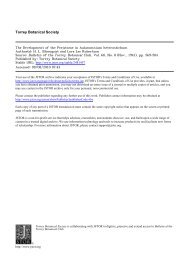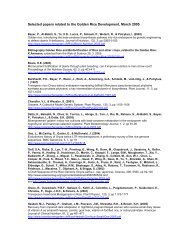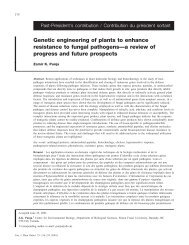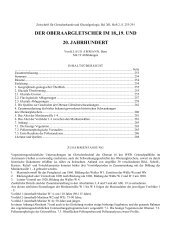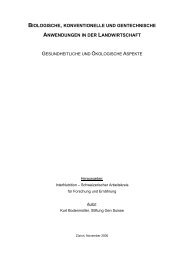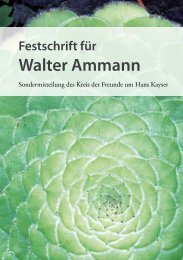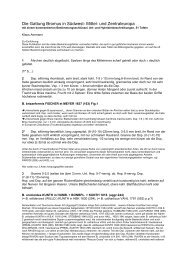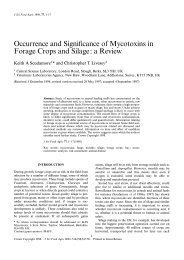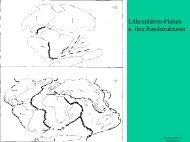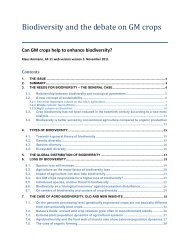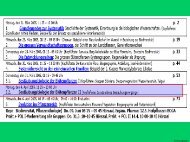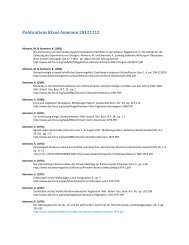Mycotoxins (Ochratoxin A, Citrinin, and Sterigmatocystin ) and ...
Mycotoxins (Ochratoxin A, Citrinin, and Sterigmatocystin ) and ...
Mycotoxins (Ochratoxin A, Citrinin, and Sterigmatocystin ) and ...
Create successful ePaper yourself
Turn your PDF publications into a flip-book with our unique Google optimized e-Paper software.
<strong>Mycotoxins</strong> (<strong>Ochratoxin</strong> A, <strong>Citrinin</strong>, <strong>and</strong> <strong>Sterigmatocystin</strong> ) <strong>and</strong><br />
Toxigenic Fungi in Grains <strong>and</strong> Other Agricultural Products<br />
MYCOTOXINS AND TOXIGENIC FUNGI<br />
Peter M. Scott,” Wilhelmina van Walbeek, Barry Kennedy, <strong>and</strong> Defenser Anyeti<br />
<strong>Ochratoxin</strong> A was detected in 18 out of 29 samples<br />
of heated grain from Saskatchewan farms at con-<br />
centrations of 0.03 to 27 ppm. After development<br />
of an appropriate screening method, 13 of these<br />
samples were also found to contain citrinin (0.07 to<br />
80 ppm). <strong>Sterigmatocystin</strong> was detected in one<br />
grain sample. Strains of Penicillium ciridicatum<br />
Westling or P. palitans Westling, producing either<br />
ochratoxin A or citrinin or (usually) both toxins<br />
concomitantly, were isolated from 22 grain samples<br />
(including 16 of those containing ochratoxin A), from<br />
three samples of mixed feeds (one of which contained<br />
ochratoxin A), from four samples of dried white<br />
beans (three containing ochratoxin A), <strong>and</strong> from an<br />
ochratoxin A positive sample of moldy peanuts.<br />
P. cyclopium Westling that produced penicillic acid<br />
was isolated quite frequently, particularly from mixed<br />
feeds, although the mycotoxin itself was not found in<br />
the samples. Zearalenone was identified in a culture<br />
of Fusarium equiseti (Corda) Sacc. isolated from a<br />
wheat sample.<br />
0<br />
chratoxin A [(-)-N-[(5-chloro-8-hydroxy-3-methyl-loxo-7-isochrornanyl)carbonyl]-3-phenylalanine~<br />
, one<br />
of six closely related metabolites (Steyn <strong>and</strong> Holzapfel,<br />
[2,3-c]xanthen-7-one], a carcinogenic metabolite of Aspergillus<br />
cersicolor, A. nidulans, A. rugulosus, P. luteum, <strong>and</strong><br />
a Bipolaris sp. (Ballantine et ai., 1965; Dean, 1963; Holzap-<br />
1967), was first isolated from a strain of Aspergillus ochraceus fel et ai., 1966; Purchase <strong>and</strong> van der Watt, 1970), were also<br />
Wilh. (van der Merwe et ai,, 1965). Other members of the A. included in the analytical screening procedures. Fungi isoochraceus<br />
group <strong>and</strong> also Penicillium ciridicarum Westling lated from samples were screened for their mycotoxin-prohave<br />
since been shown to produce the toxin (Lai et al., 1970; ducing ability (Scott et al., 1970a), whereupon it became apvan<br />
Walbeek et a/., 1969). <strong>Ochratoxin</strong> A has a high acute parent that, in addition to ochratoxin A, citrinin <strong>and</strong> penitoxicity<br />
to ducklings, rats, chicks, <strong>and</strong> rainbow trout <strong>and</strong> cillic acid were significant potential problems requiring recauses<br />
kidney <strong>and</strong> liver damage (Doster et al., 1971 ; Peckham analysis of many of the samples for these mycotoxins.<br />
et af., 1971 ; Purchase <strong>and</strong> Theron, 1968; Theron et al., 1966);<br />
in pregnant rats it induces fetal death <strong>and</strong> resorption (Still et<br />
MATERIALS AND METHODS<br />
al., 1971). Subacute toxicity of ochratoxin A to chickens <strong>and</strong> Samples. Grain samples coded D (Table I) were associated<br />
rats is evident at levels as low as 0.2 ppm in the feed (Munro with lung problems in farmers <strong>and</strong> elevator operators <strong>and</strong><br />
et a/., 1972; Tucker <strong>and</strong> Hamilton, 1971). Although ochra- were collected from farm storage bins in Saskatchewan (Dentoxin<br />
A was not found carcinogenic to rats (Purchase <strong>and</strong> van<br />
der Watt, 1971), it produced liver tumors in rainbow trout<br />
nis, 1972). The grain had been harvested in 1968, when an<br />
estimated 70 % or more of the harvest was stored under damp<br />
when fed together with sterculic acid (Doster et al., 1971). conditions, resulting in heating <strong>and</strong> spoilage (Dennis, 1972).<br />
<strong>Citrinin</strong> (4,6-dihydro-8-hydroxy-3,4,5-trimethyl-6-oxo-3H- Dilution plate counts previously carried out on five of these<br />
2-benzopyran-7-carboxylic acid) <strong>and</strong> penicillic acid (3-me- samples (Wallace, 1970) indicated that Penicillium ciridicatum<br />
thoxy-5-methyl-4-oxo-2,5-hexadienoic acid) are toxic antibiot- predominated on samples D-29, D-43, D-36, <strong>and</strong> D-68 <strong>and</strong><br />
ics pi oduced by several species of Aspergillus <strong>and</strong> Penicillium Aspergillus aersicolor on sample D-45. Two moldy grain<br />
(Korzybski et al., 1967). Like ochratoxin A, citrinin causes samples (C70/661 <strong>and</strong> A 70/861; Table 1) <strong>and</strong> all feeds listed<br />
kidney damage in experimental animals (Ambrose <strong>and</strong> DeEds, in Table I1 were associated with the deaths of farm animals.<br />
1946; Krogh et al., 1970), while penicillic acid has been found<br />
to cause local tumors on subcutaneous injection in rats <strong>and</strong><br />
Additional to samples listed in Tables I <strong>and</strong> 11, seven other<br />
grain samples (four associated with sickness or death in farm<br />
mice (Dickens <strong>and</strong> Jones, 1965).<br />
animals), six more mixed feeds (all associated with veterinary<br />
<strong>Ochratoxin</strong> A has been detected jn occasional samples of<br />
U. S. corn <strong>and</strong> barley (Nesheim, 1971; Shotwell et al., 1971).<br />
problems), <strong>and</strong> samples of rapeseed-mustard pellets, rapeseed,<br />
<strong>and</strong> moldy peas were screened for mycotoxins <strong>and</strong>, in some<br />
We have reported the presence of ochratoxin A in a sample of cases, for mycotoxin-producing fungi.<br />
heated wheat from Alberta (Scott et ai., 1970b). Strains of Analysis of <strong>Mycotoxins</strong> in Agricultural Products. Samples<br />
Penicillium viridicatum that produced ochratoxin A alone or of grains <strong>and</strong> other materials were ground (20 mesh) <strong>and</strong><br />
together with citrinin predominated on the grain when incu- analyzed for ochratoxin A, aflatoxins B1, B2, GI, <strong>and</strong> G2,<br />
bated at 12”. We thus decided to routinely look for ochra- sterigmatocystin, <strong>and</strong> zearalenone by either the “Best Foods”<br />
toxin A, in addition to aflatoxins, in samples of heated grains, method (Waltking et al., 1968), modified by using three<br />
moldy feeds, <strong>and</strong> other foodstuffs. Zearalenone [(S)-( -)-<br />
3,4,5,6,9,10 - hexahydro - 14,16 - dihydroxy- 3-methyl-1H-2-benzoxacyclotetradecin-l,7(8H)-dione],<br />
an estrogenic Fusarium<br />
chloroform extractions of the methanol-water phase to effect<br />
complete transfer of ochratoxin A (Method l), or the multimycotoxin<br />
method of Stoloff et ul. (1971), using 20- or 25-g<br />
mycotoxin (Mirocha et al., 1967), <strong>and</strong> sterigmatocystin<br />
f 3a,l2c-dihydro-8-hydroxy-6-methoxy-7H-furo[3 ’,2’ :4,5]furosamples<br />
without reduction of solvent volumes (Method 2).<br />
Method 2 was found to be preferable for wheat because of<br />
troublesome emulsions with Method 1. Most of the com-<br />
Food Research Laboratories, Health Protection Branch,<br />
Department of National Health <strong>and</strong> Welfare, Ottawa, Ontario,<br />
K1A OL2, Canada,<br />
modities from which citrinin-producing fungi were isolated were<br />
later reanalyzed for citrinin (<strong>and</strong> ochratoxin A) by Method 2<br />
with the inclusion of 2 ml of 20% sulfuric acid in the 200-ml<br />
J. AGR. FOOD CHEM., VOL. 20, NO. 6, 1972 1103
SCOTT et al.<br />
Type<br />
Wheat<br />
Wheat<br />
Grain<br />
Wheat<br />
Wheat<br />
Wheat<br />
Oats + barley<br />
Wheat<br />
Wheate<br />
Oats<br />
Wheat<br />
Wheat<br />
Wheat<br />
Wheat<br />
Wheat<br />
Wheat<br />
Wheat<br />
Wheat<br />
Wheat<br />
Wheat<br />
Wheat +<br />
wild oats<br />
Rye<br />
Barley<br />
Rye<br />
Wheat<br />
Table I. <strong>Ochratoxin</strong> A, <strong>Citrinin</strong>, <strong>and</strong> Penicillic Acid in Grains <strong>and</strong> Isolated Strains of Penicillium spp.<br />
Sample<br />
Isolated fungi<br />
Code<br />
<strong>Ochratoxin</strong> A.<br />
ppm<br />
<strong>Citrinin</strong>,<br />
ppm<br />
Penicillic<br />
acid Species<br />
Strain<br />
no.<br />
<strong>Ochratoxin</strong><br />
A= <strong>Citrinin</strong>a<br />
C 701661<br />
A 701786<br />
A 701861<br />
Birsay<br />
L<strong>and</strong>is<br />
D-29<br />
D-36<br />
D-43<br />
D-45<br />
D-68<br />
D-16<br />
D-18<br />
D-23<br />
D-30<br />
D-34<br />
D-52<br />
D-62<br />
D-63<br />
D-66<br />
D-67<br />
NDb<br />
0.13<br />
ND<br />
0.18 (0.7)d<br />
ND (0.03)d<br />
0.13 (0.62)d<br />
11 ( 22)d<br />
1.3 (1.6)d<br />
ND<br />
0.46 (3.0)d<br />
ND (0. l)d<br />
ND (ND)d<br />
ND (ND)d<br />
0.08 (0.27)d<br />
0.12(0.20)d<br />
0.13 (0.14)d<br />
4.5 (3.2)d<br />
2.5 (3.3)d<br />
0.07 (0.21)d<br />
2.1 (1.5)d<br />
2.1<br />
0.1<br />
2.0<br />
60<br />
2.4<br />
10<br />
ND<br />
ND<br />
ND<br />
0.28<br />
ND<br />
ND<br />
1.7<br />
1 .o<br />
0.07<br />
6.7<br />
ND<br />
ND<br />
ND<br />
ND<br />
ND<br />
ND<br />
ND<br />
ND<br />
ND<br />
P. cyclopiumc<br />
P. cyclopiumc<br />
P. viridicatumc<br />
P. airidicatum<br />
P. airidicatum<br />
P. uiridicatumc<br />
P. viridicatumc<br />
P. viridicatumc<br />
P. airidicatumc<br />
P. airidicatumc<br />
P. viridicatumc<br />
P. airidicatumc<br />
P. uiridicatumc<br />
P. airidicaturn<br />
P. airidicatum<br />
P. ciridicatum<br />
P. oiridicatum<br />
P. airidicatum<br />
P. ciridicatum<br />
P. airidicatum<br />
P. cyclopiumc<br />
P. ciridicatum<br />
P. cyclopium<br />
P. viridicatum<br />
P. cyclopium<br />
335<br />
414<br />
489a<br />
598<br />
561<br />
481<br />
482<br />
487<br />
488<br />
479<br />
480<br />
484<br />
486<br />
541<br />
5 60<br />
564<br />
543a<br />
568<br />
570<br />
547<br />
548<br />
572<br />
574<br />
597<br />
551<br />
NDb<br />
ND<br />
+<br />
+<br />
ND<br />
ND<br />
+<br />
ND<br />
+<br />
ND<br />
+<br />
ND<br />
+<br />
ND<br />
ND<br />
ND<br />
+<br />
+<br />
ND<br />
+<br />
ND<br />
+<br />
ND<br />
+<br />
ND<br />
+<br />
ND<br />
D-69A<br />
D-74<br />
D-76<br />
D-83<br />
D-85<br />
0.07 (0. 07)d<br />
ND (ND)d<br />
ND (ND)d<br />
0.24(0.72)d<br />
19 (27)d<br />
ND<br />
ND<br />
ND<br />
0.96<br />
80<br />
ND<br />
ND<br />
ND<br />
P. ciridicatum<br />
P. cyclopium<br />
P. ciridicatum<br />
P. ciridicatum<br />
P. cyclopiumc<br />
P. airidicatum<br />
P. airidicatum<br />
596<br />
553<br />
555<br />
556<br />
557<br />
558<br />
586<br />
ND<br />
ND<br />
+<br />
ND<br />
+<br />
+<br />
+<br />
ND<br />
+<br />
+<br />
ND<br />
+<br />
+<br />
Penicillic<br />
aci&<br />
+<br />
ND<br />
ND<br />
ND<br />
ND<br />
ND<br />
ND<br />
ND<br />
ND<br />
ND<br />
ND<br />
ND<br />
ND<br />
ND<br />
ND<br />
ND<br />
ND<br />
ND<br />
ND<br />
+<br />
ND<br />
a Toxins produced on yeast extract (2z)-sucrose (15 %) medium. ND = not detected. Identified at the Centraalbureau voor Schimmelcultures,<br />
Baarn. Determinations in parentheses refer to later reanalysis by Method 2A (same extract used for the citrinin determination). e Sample<br />
contained sterigmatocystin (approximately 0.3 ppm).<br />
acetonitrile-aqueous KCl extraction mixture (Method 2A).<br />
A few samples (grains D-29, D-36, D-43, <strong>and</strong> D-68 <strong>and</strong><br />
peanuts 107043 U) were analyzed for ochratoxin A, citrinin,<br />
<strong>and</strong> the other mycotoxins by Method 1, with the addition of<br />
the same proportion of sulfuric acid to the methanol-water<br />
extraction mixture (Scott et al., 1970b) (Method 1A); this<br />
method did not give good recoveries of citrinin from spiked<br />
grains (Table 111) <strong>and</strong> all results recorded for citrinin in Tables<br />
I <strong>and</strong> I1 (except for the peanuts) were determined by Method<br />
2A. The mink feeds M-2 <strong>and</strong> M-3 (Table 11) were analyzed<br />
by method 2A only. Penicillic acid <strong>and</strong> patulin were looked<br />
for by the method of Scott <strong>and</strong> Somers (1968) (wheat C 70/<br />
661 <strong>and</strong> feeds 49 FHR 49, 49 FHR 67, 49 FHR 181, <strong>and</strong><br />
Medicine Hat), Method 2, or Method 2A, particularly in<br />
samples that harbored fungi producing these mycotoxins.<br />
Recovery experiments to assess the validity of Methods 1, lA,<br />
2, <strong>and</strong> 2A were carried out with powdered Selkirk wheat (or<br />
other foodstuff) spiked with appropriate toxins <strong>and</strong> analyzed<br />
immediately (Table 111). Sample D-45 was analyzed for<br />
sterigmatocystin by the method of Stack <strong>and</strong> Rodricks (1971).<br />
Thin-layer chromatography (tlc) of mycotoxins <strong>and</strong> sample<br />
extracts was performed on silica gel layers (Adsorbosil 5 01<br />
Analtech silica gel G) developed with toluene-ethyl acetate-<br />
90% formic acid (6:3:1, v/v/v; TEF) (Scott et a/., 1970a).<br />
Toxins were estimated by visual comparison with known<br />
amounts of st<strong>and</strong>ard spotted on the same tlc plate. St<strong>and</strong>ard<br />
ochratoxin A solutions of 10 pg/ml or 1 pg/ml in benzene<br />
$0.25 acetic acid were used; the lowest st<strong>and</strong>ard concen-<br />
1104 J. AGR. FOOD CHEM., VOL. 20, NO. 6, 1972<br />
+<br />
+<br />
ND<br />
ND<br />
+<br />
ND<br />
ND<br />
+<br />
ND<br />
ND<br />
tration of citrinin was 10 pg/ml (in benzene). Estimation of<br />
ochratoxin A after ammonia treatment (Scott <strong>and</strong> H<strong>and</strong>, 1967)<br />
was necessary if citrinin interfered ; otherwise estimates before<br />
<strong>and</strong> after ammonia (green <strong>and</strong> blue fluorescent spots, respec-<br />
tively, under ultraviolet light) were generally averaged.<br />
<strong>Ochratoxin</strong> A was confirmed by tlc in the solvent system<br />
benzene-methanol-acetic acid (24 :2 : 1, v/v/v; BMA), by<br />
solubility in sodium bicarbonate solution, <strong>and</strong> by formation of<br />
the fluorescent methyl ester on a microgram scale on heating<br />
the tlc-purified ochratoxin A 10 min with BF3-methanol,<br />
followed by evaporation of the solvents <strong>and</strong> tlc.<br />
<strong>Citrinin</strong> estimations were carried out without delay after<br />
extraction <strong>and</strong> concentration of the extract. Ether-metha-<br />
nol-water-90 % formic acid (95 :4 : 1 : 1, v/v/v/v; lined tank<br />
saturated with ether) was a preferable tlc solvent system for<br />
estimation of citrinin; confirmation of identity was obtained<br />
with ammonia, which washed out the yellow fluorescence, <strong>and</strong><br />
then by spraying with fresh BF,-methanol, which gave a green<br />
fluorescence. <strong>Sterigmatocystin</strong> was detected after tlc of<br />
sample D-45 extract by an aluminum chloride spray (Stack<br />
<strong>and</strong> Rodricks, 1971) <strong>and</strong> confirmed by formation of acid <strong>and</strong><br />
acetate derivatives (Stack <strong>and</strong> Rodricks, 1971).<br />
Two-dimensional tlc in the solvent systems ether <strong>and</strong> TEF<br />
was used to estimate penicillic acid recovered fI om spiked<br />
wheat. Acetone-chloroform (1 : 9, v/v) was an additional<br />
solvent system used for estimation of aflatoxin recoveries.<br />
Isolation <strong>and</strong> Culture of Fungi. MEDIA. The following<br />
media were used: for identification of fungi, Czapek solution
MYCOTOXINS AND TOXIGENIC FUNGI<br />
Table 11. <strong>Ochratoxin</strong> A, <strong>Citrinin</strong>, <strong>and</strong> Penicillic Acid in Feeds, Beans, Peanuts, <strong>and</strong> Isolated Strains of<br />
Penicillium <strong>and</strong> Aspergillus spp.<br />
Isolated fungi<br />
Sample<br />
Peni-<br />
<strong>Ochratoxin</strong> A. Citri- ~enicillic<br />
Strain Ochra- Citri- cilli~<br />
Type<br />
Code<br />
PPm nin acid Species no. toxin Aa nina acidQ<br />
Mixed feed<br />
49 FHR 49<br />
NDb<br />
ND P. ciridicatumc 220 NDb ND +<br />
(dairy ration)<br />
P. cyclopiumC 221 ND ND +<br />
Horse feed<br />
49 FHR 67<br />
0.02<br />
ND P. cyclopiumc 324 ND ND +<br />
A. ostianus" 325 ND ND<br />
Mixed feed (pelleted 49 FHR 181 0.53 (0.17)d ND ND P. ciridicatumc 490 +<br />
+<br />
+ ND<br />
dairy ration)<br />
P. cyclopiumC 227 ND ND +<br />
Chicken feed (Riddell et al., ND<br />
P. ciridicatumc 475 + + ND<br />
1971)<br />
P. cyclopium 354 ND ND<br />
Mixed feed (cattle) Medicine Hat ND<br />
ND P. palitansc 583 + +<br />
+<br />
ND<br />
Mink feed<br />
M-2<br />
ND ND ND P. cyclopium 591 ND ND +<br />
Mink feed<br />
M-3<br />
ND ND ND P. cyclopium 592 ND ND<br />
Dried white beans 37852 U 0.05 (0.03)d ND<br />
P. ciridicatumc 413 +<br />
Dried white beans 37790 U 0.50 (0. 02)d ND<br />
P. viridicatumc 414 +<br />
+<br />
+<br />
ND<br />
+ ND<br />
Penicillium sp. 590 ND + ND<br />
(white mutant)<br />
Dried white beans 141007 U 2.1 (1.9)d ND ND P. cyclopium 565 ND ND +<br />
(powdered)<br />
P. palitansc 495 ND + ND<br />
Dried white beans Retail sample ND<br />
P. ciridicatumc 469 + + ND<br />
P. cyclopium 387 ND ND<br />
Peanuts<br />
107043 U<br />
4.9 ND<br />
P. ciridicatumc 476 +<br />
+<br />
ND ND<br />
P. cyclopiumc 439 ND ND +<br />
a Toxins produced on yeast extract (2%)-sucrose (15%) medium. ND = not detected. c Identified at the Centraalbureau voor Schimmelcultures,<br />
Baarn. Determinations in parentheses refer to later reanalysis by Method 2A (same extract used for the citrinin determination).<br />
Table 111. Recoveries of <strong>Ochratoxin</strong> A, <strong>Citrinin</strong>, <strong>and</strong> Other <strong>Mycotoxins</strong> Added to Powdered Grains <strong>and</strong> Beans<br />
Method 1 Method 1A Method 2<br />
Method 2A<br />
Mycotoxin<br />
Concn added,n<br />
ppm<br />
Recovery,<br />
z<br />
~~<br />
Concn added,a Recovery, Concn added,a Recovery, Concn added,a Recovery,<br />
ppm z ppm z ppm 75<br />
<strong>Ochratoxin</strong> A<br />
<strong>Citrinin</strong><br />
<strong>Sterigmatocystin</strong><br />
Zearalenone<br />
Penicillic acid<br />
Aflatoxin B1<br />
Aflatoxin GI<br />
Aflatoxins B2, Gz<br />
0.50b<br />
0.19<br />
0.454<br />
3.16<br />
0. 095e<br />
0.454e<br />
1 .o<br />
20.0<br />
100<br />
1.0b<br />
5.0b<br />
100<br />
80<br />
68<br />
88d<br />
100<br />
102<br />
0<br />
0.7<br />
0.8<br />
60<br />
100<br />
0.10<br />
0.05~<br />
0.25<br />
0.50<br />
1 .o<br />
5.06<br />
0.050~<br />
0. O5Oc<br />
0. 025c<br />
90<br />
l00d<br />
0<br />
20<br />
40<br />
10d<br />
l00d<br />
l00d<br />
lOOd<br />
0.05<br />
0.20<br />
1 .o<br />
5.0<br />
4.0<br />
0.050<br />
0.050<br />
0.025<br />
100<br />
93<br />
86<br />
0<br />
60-80<br />
100<br />
100<br />
100<br />
0.05<br />
0.20<br />
1 .o<br />
0.50<br />
1 .o<br />
5.0<br />
5.0<br />
4.0<br />
0.050<br />
0.050<br />
0.025<br />
85<br />
94<br />
113<br />
63<br />
86<br />
100<br />
100<br />
30-60<br />
82<br />
98<br />
98<br />
' Toxin added to powdered wheat except where indicated.<br />
used for partition step. e Added to powdered beans.<br />
Added to powdered barley. Added to rye flour. Total of 200 ml of CHCIJ<br />
agar with <strong>and</strong> without 5 z NaCI, malt agar (Difco products),<br />
<strong>and</strong> steep agar (Raper <strong>and</strong> Thom, 1968); for production of<br />
mycotoxins, 15 z sucrose plus 2 z yeast extract (YES) (Davis<br />
et al., 1966); for isolation of single spore cultures <strong>and</strong> pro-<br />
duction of spore crops, potato dextrose agar prepared with<br />
fresh potatoes according to the Difco formula (FPDA); <strong>and</strong><br />
for preparation of spore suspensions, sterile aqueous 0.05<br />
polyoxyethylene sorbitan monooleate (Tween 80).<br />
MONO-SPORE CULTURES. Light suspensions of spores were<br />
cross-streaked on FPDA plates (4 mm thick). After 24-hr<br />
incubation at 25", plates were viewed on an inverted microscope<br />
to locate single germinating spores which were excised<br />
with sterile capillary tubes (1 mm diameter), inoculated on<br />
FPDA, <strong>and</strong> incubated at 25 until cultures sporulated heavily.<br />
ISOLATION, SCREENING, AND IDENTIFICATION OF FUNGI. The<br />
samples examined for fungi producing known mycotoxins are<br />
listed in Tables I <strong>and</strong> 11. The method for isolation of fungi<br />
was based on that of Wallace <strong>and</strong> Sinha (1962). Sterile<br />
Whatman No. 1 filter paper disks in sterile plastic petri plates<br />
were dampened with 2 ml of YES <strong>and</strong> seeded with 10 to 20<br />
seeds, seed fragments, or 1 to 2 g of particulate samples.<br />
Individual plates were enveloped in polyethylene bags <strong>and</strong><br />
incubated at 10". After 14 days, plates were examined daily<br />
under a stereoscopic microscope for fungal growth. After 21<br />
days, plates were transferred to a 25" incubator <strong>and</strong> examined<br />
at intervals dictated by the nature of the outgrowing fungi.<br />
As mycelial growth <strong>and</strong> sporulation occurred, spores from<br />
single sporophores of representative fungi were picked with a<br />
fine loop (1 mm diameter) coated with a film of Tween 80<br />
solution to which spores readily adhered. This small inocu-<br />
lum was dispersed in 0.5 ml of Tween 80 solution using a vor-<br />
tex mixer. Part of this suspension was cultured on FPDA<br />
slopes <strong>and</strong> the remainder on 5 ml of YES (van Walbeek et al.,<br />
1968). Chloroform extracts of the latter cultures were ini-<br />
J. AGR. FOOD CHEM., VOL. 20, NO. 6, 1972 1105
SCOTT et al.<br />
0<br />
0- -<br />
0<br />
Lo- P<br />
0<br />
0-<br />
y1<br />
0<br />
44 206<br />
n.. I77<br />
N<br />
0<br />
0 I1 I 111111/<br />
m /e<br />
191<br />
217<br />
232<br />
250<br />
I I,, I, ,<br />
Figure 1. Mass spectrum of citrinin from PeniciNium palitans isolate no. 495 recorded with a Perkin-Elmer RMS-4 instrument at 80 eV (source<br />
temperature 200 O, probe temperature 95 ")<br />
tially screened for known mycotoxins by the method of Scott<br />
et al. (1970a). Those cultures producing mycotoxins were<br />
noted <strong>and</strong> the corresponding FPDA cultures were used to<br />
obtain mono-spore cultures, which were rechecked for toxin<br />
production (uide infra) after 7-9 days of incubation at room<br />
temperature, usually on 200 ml of YES in 2.8-1. Fernbach<br />
flasks. Culture liquids were decanted out of the Fernbach<br />
flasks <strong>and</strong> the mycelial mats were flooded with 250 ml of<br />
chloroform, heated in a 60" water bath for 10 min, <strong>and</strong> then<br />
allowed to soak for 18 hr at room temperature. Where<br />
necessary, culture extracts were concentrated under a stream of<br />
nitrogen. Spore suspensions from the mono-spore cultures<br />
were also preserved in sterile dry soil (Raper <strong>and</strong> Fennell,<br />
1965). These were submitted to Centraalbureau voor<br />
Schimmelcultures, Baarn (CBS), for identification or were<br />
identified in this laboratory by comparison with the CBS cul-<br />
tures on the media specified above (Raper <strong>and</strong> Thom, 1968).<br />
In addition to using the routine isolation procedure, detec-<br />
tion of ochratoxin A <strong>and</strong> citrinin-producing fungi was greatly<br />
aided by briefly viewing the filter paper cultures over a Blak-<br />
Ray longwave ultraviolet transilluminator (model C-50) after<br />
2 weeks at 10". Green-blue <strong>and</strong> brilliant yellow fluorescing<br />
areas observed in the YES-impregnated filter paper were out-<br />
lined on the plates, <strong>and</strong> spores from sporophores emerging<br />
from the marked areas were picked as described above. Al-<br />
though penicillic acid <strong>and</strong> patulin do not fluoresce under these<br />
circumstances, many strains producing these toxins frequently<br />
were observed to secrete in the filter paper fluorescent sub-<br />
stances, which soon became associated with production of<br />
these toxins <strong>and</strong> hence aided detection of the responsible fungi.<br />
Characterization of <strong>Mycotoxins</strong> in Fungal Extracts. Thin-<br />
layer chromatography of ochratoxin A <strong>and</strong> citrinin in fungal<br />
extracts was carried out by comparison with st<strong>and</strong>ards in<br />
three systems: TEF-silica gel, BMA-silica gel, <strong>and</strong> TEF-<br />
acidic alumina (Woelm). Confirmatory tests were ammonia<br />
treatment <strong>and</strong> BFI-methanol spray (for citrinin). Additional<br />
confirmation by solubility in sodium bicarbonate solution <strong>and</strong><br />
tlc of the methyl ester formed with BFs-methanol was ob-<br />
tained for tlc-purified ochratoxin A (approximately 0.3 mg)<br />
isolated from Penicillium palitans strain no. 583 (mycelium).<br />
Crystalline ochratoxin A, mp 93-95 O (from benzene), was<br />
obtained from the mycelium extract of P. viridicatum strain<br />
no. 476 after preparative tlc (TEF-silica gel), <strong>and</strong> identified by<br />
mixed melting point with authentic ochratoxin A <strong>and</strong> compari-<br />
son of quantitative ultraviolet spectrum, infrared spectrum,<br />
1106 J. AGR. FOOD CHEM., VOL. 20, NO. 6, 1972<br />
<strong>and</strong> mass spectrum with those of the st<strong>and</strong>ard. Crystalline<br />
citrinin, mp 176-179" (dec), was isolated from the acidified<br />
culture liquid of P. palitans strain no. 495 after chloroform<br />
extraction, preparative tlc (TEF-silica gel), <strong>and</strong> recrystallization<br />
from ethanol, <strong>and</strong> identified by comparison with st<strong>and</strong>ard<br />
citrinin using the same criteria as for crystalline ochratoxin A.<br />
The mass spectrum, which has not been previously published,<br />
is shown in Figure 1. Samples of tlc-pure citrinin (not recrystallized)<br />
were obtained from the acidified culture liquids of<br />
P. uiridicatum strains no. 541 <strong>and</strong> no. 561 <strong>and</strong> from the mycelium<br />
extract of P. palitans strain no. 583 following preparative<br />
tlc in 2-3 solvent systems, which included the ether-methanolformic<br />
acid-water (95 : 4 : 1 : 1) system for the ochratoxin A-<br />
producing fungi (no. 561 <strong>and</strong> 583); identification of the<br />
citrinin was by ultraviolet <strong>and</strong> mass spectral comparison with<br />
st<strong>and</strong>ard.<br />
Penicillic acid <strong>and</strong> patulin were detected in the tlc system<br />
TEF-silica gel by spraying <strong>and</strong> heating with acidic anisaldehyde<br />
(Scott et al., 1970a). They were confirmed <strong>and</strong> visually<br />
estimated (Fernbach flask cultures) after development on silica<br />
gel with ether, spraying with 4 phenylhydrazine hydrochloride<br />
solution, <strong>and</strong> heating at 120" for 3 min; penicillic acid<br />
formed a yellow fluorescent spot under longwave ultraviolet<br />
light <strong>and</strong> patulin formed a yellow spot under visible light.<br />
Crystalline penicillic acid samples, mp 85-86' <strong>and</strong> 83.5-85 ",<br />
respectively, were obtained from Penicillium cyclopium strain<br />
no. 551 (CH2C12 extract of culture liquid) <strong>and</strong> strain no. 557<br />
(mycelium extract) after preparative tlc (ether-silica gel),<br />
recrystallization from benzene-n-hexane, <strong>and</strong> (557 sample)<br />
sublimation under reduced pressure; the samples were identified<br />
by comparison with authentic penicillic acid (mixed<br />
melting point, <strong>and</strong> infrared, mass, <strong>and</strong> quantitative ultraviolet<br />
spectra). Crystalline patulin was isolated from P. patulurn<br />
strain no. 562 (Scott et a[., 1972). Griseofulvin was detected<br />
by its blue fluorescence under ultraviolet light at the same Rr<br />
as st<strong>and</strong>ard in the tlc systems TEF-silica gel <strong>and</strong> ether-silica<br />
gel.<br />
<strong>Sterigmatocystin</strong> <strong>and</strong> zearalenone wexe detected as fluorescent<br />
spots by comparison with st<strong>and</strong>ards in ether or TEFsilica<br />
gel <strong>and</strong> BMA-silica gel; in addition aluminum chloride<br />
(Stack <strong>and</strong> Rodricks, 1971) <strong>and</strong> acidic anisaldehyde (Scott et<br />
al., 1970a) were used as respective spray reagents. The<br />
identity of zearalenone isolated by preparative tlc (TEF-silica<br />
gel) from the mycelium extract of Fusarium equiseti strain<br />
no. 577 was confirmed by gas chromatography (gc) of the
trimethylsilyl ether [6 ft X '18 in. stainless steel column packed<br />
with 3x SE-30 on Chromosorb W (HP) 8Ojl00, column<br />
temperature 260°, injector temperature 300°, flame ionization<br />
detector temperature 300°, 35 ml/min He].<br />
RESULTS AND DISCUSSION<br />
<strong>Mycotoxins</strong> in Grains <strong>and</strong> Other Agricultural Products.<br />
<strong>Ochratoxin</strong> A war detected <strong>and</strong> confirmed in 18 samples of<br />
grain (out of 32 samples examined) <strong>and</strong> two mixed feeds (out<br />
of 13 samples examined), in addition to three samples of<br />
dried white beans <strong>and</strong> one sample of peanuts previously found<br />
positive by Health Protection Branch Regional Laboratories<br />
(Tables I <strong>and</strong> 11). No ochratoxin B or ochratoxin esters were<br />
observed in any sample. Concentrations of ochratoxin A in<br />
the 18 grain specimens ranged from 0.03 to 27 ppm <strong>and</strong> in 13<br />
of these grains citrinin was also detected (at levels of 0.07-80<br />
pprn). Differences in ochratoxin A concentrations found on<br />
reanalysis of the same sample by Method 2A are probably<br />
either due to sampling error (most of the samples were
SCOTT et al.<br />
Tables I <strong>and</strong> 11, the majority (25) produced ochratoxin A <strong>and</strong><br />
citrinin in the same culture, while three produced ochratoxin A<br />
alone <strong>and</strong> five produced only citrinin. Strain no. 476 was the<br />
best producer of ochratoxin A (31 mg was estimated in the<br />
extract from one mycelial mat of a Fernbach flask culture);<br />
<strong>and</strong> strains no. 495, 541, <strong>and</strong> 561 yielded the most citrinin<br />
(about 20 mg per mycelium extract).<br />
With the exception of isolates identified as Aspergillus CONCLUSION<br />
ostianus, from horsefeed sample 49 FHR 67, <strong>and</strong> Penicillium<br />
uiridicatum from mixed feed 49 FHR 49, all the strains pro-<br />
ducing penicillic acid were identified as P. cyclopium. It is of<br />
interest that penicillic acid producing fungi were isolated from<br />
six feed samples, in addition to one grain sample, associated<br />
with deaths of farm animals. Of all 16 P. cyclopium strains<br />
isolated, strain no. 548 was the best producer, yielding 60 mg<br />
in the mycelium extract from one Fernbach flask. Penicillic<br />
acid has previously been reported from P. cyclopium (Korzyb-<br />
ski et al., 1967) but not from P. viridicatum or A. ostianus.<br />
The amounts of ochratoxin A, citrinin, <strong>and</strong> penicillic acid<br />
found in fungal extracts are not recorded in Tables I <strong>and</strong> 11.<br />
Soaking the mycelial mats in chloroform does not give a quan-<br />
titative recovery of these mycotoxins. For example, experi-<br />
ments with three penicillic acid producing Penicillium cyclo-<br />
pium isolates grown in Fernbach flasks showed that only 49-<br />
58% of the penicillic acid in the mycelium was extracted by<br />
the soaking procedure ; the remainder was extracted by blend-<br />
ing the mycelium three times with chloroform. In addition,<br />
the culture medium contained 1.3-3.0 times more penicillic<br />
acid than the total present in the mycelium (similar ratios were<br />
observed for ochratoxin A <strong>and</strong> citrinin in experiments with<br />
three isolates of P. ciridicatum).<br />
The frequency with which toxigenic strains of Penicillium<br />
ciridicatum <strong>and</strong> P. cyclopium were isolated from the various<br />
commodities suggests that these are common storage fungi in<br />
wheat, rye, barley, white beans, peanuts, <strong>and</strong> animal feeds.<br />
The occurrence of ochratoxin A <strong>and</strong> citrinin in these products<br />
(Tables I <strong>and</strong> 11) reflects inferior storage conditions <strong>and</strong> also<br />
possibly the lengthy Canadian winter, which could permit the<br />
associated toxigenic strains of Penicillium to gain ascendency<br />
over other less cold tolerant microflora. Mislivec <strong>and</strong> Tuite<br />
(1970) have reported the growth minima of P. oiridicatum <strong>and</strong><br />
P. cjdopium to be -2”.<br />
Stolk (1972), who identified many of our fungi, commented<br />
on the typical variation in color of our strains of Penicillium<br />
ciridicatum <strong>and</strong> 17’. cyclopium. Since the penicilli of these<br />
organisms are almost identical, identification was mainly<br />
based on color of the colonies. Strains no. 495 <strong>and</strong> no. 583<br />
showed blue shades in young colonies on Czapek agar, but<br />
with age they developed the characteristic dark green color<br />
typical of P. palirans. Strain 325 was tentatively identified<br />
as Aspergillus ostianus Wehmer. Unfortunately, cultures of<br />
this organism failed to develop sclerotia, the color of which is<br />
one of the more important criteria used to distinguish this<br />
organism from A. ochraceus Wilhelm.<br />
Strains of Penicillium patulum (isolates no. 562 <strong>and</strong> 201)<br />
that produced patulin <strong>and</strong> griseofulvin in culture were isolated<br />
from two mixed feeds, “Medicine Hat” (Table 11) <strong>and</strong> a corn-<br />
soybean meal from Almonte, Ontario, both of which were<br />
suspected of killing farm animals. Analyses of the feed sam-<br />
ples for patulin (Scott <strong>and</strong> Somers, 1968) were negative <strong>and</strong> no<br />
other mycotoxins were detected.<br />
A Fusarium sp. (strain no. 577) that grew luxuriantly on<br />
YES <strong>and</strong> produced zearalenone within 5 days at room temper-<br />
ature was isolated from wheat sample D-66. The fungus was<br />
identified as Fusarium equiseti (Corda) Sacc. (Booth, 1972),<br />
1108 J. AGR. FOOD CHEM., VOL. 20, NO. 6, 1972<br />
which has not previously been reported as a producer of<br />
zearalenone. A more polar fluorescent compound, tenta-<br />
tively identified by mass spectrometry as a hydroxyzearalen-<br />
one, was also isolated from the culture by preparative tlc; the<br />
gc retention time of its trimethylsilyl derivative was 6.7 min<br />
<strong>and</strong> that of zearalenone bis(trimethyIsily1) ether was 5.4 min.<br />
We do not claim our findings constitute an unbiased survey<br />
for mycotoxins <strong>and</strong> mycotoxin-producing fungi in prairie<br />
grains collected at the farm level nor that we have accounted<br />
for deaths of animals that ate certain feed <strong>and</strong> grain samples.<br />
We do believe, however, that our discovery of the co-occur-<br />
rence of ochratoxin A <strong>and</strong> citrinin in grains is a problem area<br />
requiring further attention. <strong>Ochratoxin</strong> A is fairly stable in<br />
cereal products (Trenk et al., 1971) <strong>and</strong> care should be taken<br />
that contaminated grains do not enter commercial food chan-<br />
nels. The possibility that ochratoxin A <strong>and</strong> citrinin could be<br />
carried through from feeds into animal <strong>and</strong> poultry products<br />
(e.g., eggs) ought to be investigated.<br />
Penicillium uiridicatum Westling has been shown to be an<br />
important natural source of ochratoxin A <strong>and</strong> citrinin. This<br />
fungus <strong>and</strong> its associated mycotoxins appear to be responsible<br />
for kidney disease in Danish pigs (Krogh er al., 1970). Their<br />
role in mycotoxicoses of farm animals in North America has<br />
yet to be determined.<br />
ACKNOWLEDGMENT<br />
We thank John Lawrence for technical assistance during the<br />
earlier stages of this work, W. F. Miles for recording the mass<br />
spectra <strong>and</strong> gas chromatogram, W. B. Whalley for st<strong>and</strong>ard<br />
citrinin, J. V. Rodricks for sterigmatocystin, Ronald Bentley<br />
for penicillic acid, T. M. McCalla for patulin, M. C. Bachman<br />
for zearalenone, J. E. Spencer, H. A. H. Wallace, W. P.<br />
Cochrane, <strong>and</strong> R. J. Kirk for grain <strong>and</strong> feed samples, <strong>and</strong><br />
Elizabeth Hoibak <strong>and</strong> Lorne Ford for initial analyses of<br />
ochratoxin A in beans <strong>and</strong> peanuts, respectively.<br />
LITERATURE CITED<br />
Ambrose, A. M., DeEds., F., J. Pharmacof. Exp. Tiler. 88, 173<br />
(1946).<br />
Ballantine, J. A., Hassall, C. H., Jones, G., J. Chem. Soc. 4672<br />
(1965).<br />
Booth, C., Commonwealth Mycological Institute, Kew, Engl<strong>and</strong>,<br />
personal communication, 1972.<br />
Ciegler, A,, Kurtzman, C. P., Appl. Microbiol. 20, 761 (1970).<br />
Davis, N. D., Diener, U. L., Eldridge, D. W., Appf. Microbiol. 14,<br />
378 (1966).<br />
Dean, F. M., “Naturally Occurring Oxygen Ring Compounds,”<br />
Butterworths, London, 1963, p 526.<br />
Dennis, C. A. R., in “Grain Storage-Part of a System,” Sinha,<br />
R. N., Muir, W. E., Ed., Avi, Westport, Conn., 1972.<br />
Dickens, F., Jones, H. E. H., Brit. J. Cancer 19, 392 (1965).<br />
Doster, R. C., Sinnhuber, R. O., Wales, J. H., Lee, D. J., Fed. Proc<br />
Fed. Amer. Soc. Exp. Biol. 30, 578 (1971).<br />
Holzapfel, C. W., Purchase, I. F. H., Steyn, P. S., Gouws, L.,<br />
S. Afr. Med. J. 40, 1100 (1966).<br />
Korzybski, T., Kowszyk-Gindifer, Z., Kurylowicz, W., “Antibiotics,<br />
Origin, Nature <strong>and</strong> Properties,” Vol. 11, Pergamon<br />
Press, New York, N. Y., 1967.<br />
Krogh, P., Hasselager, E,, Friis, P., Acta Pathol. Microbiol. Sc<strong>and</strong>.<br />
B78,401(1970).<br />
Lai, M., Semeniuk, G., Hesseltine, C. W., Appl. Microbiol. 19,<br />
542 (1970).<br />
Mirocha, C. J., Christensen, C. M., Nelson, G. H., Appl. Microbiol.<br />
15,497 (1967).<br />
Mislivec, P. B., Tuite, T., Mycofogia 62, 75 (1970).<br />
Munro, I. C., Moodie, C. A,, Middleton, E. J., Scott, P. M.,<br />
Grice, H. C., Abstracts of the 11th Annual Meeting, Society of<br />
Toxicology, Williamsburg, Virginia, March, 5-9, 1972, p 1.1 1.<br />
Nesheim, S., Abstracts of the 85th AnnualMeetlng of the Association<br />
of Official Analytical Chemists, Washington, D. C., Oct 11-14,<br />
1971.
Peckham, J. C., Doupnik. B., Jr., Jones, 0. H., Jr., Appl. Microbiol.<br />
21,492(1971).<br />
Purchase, I. F. H., Theron, J. J., Food Cosmet. Toxicol. 6, 479<br />
(1968).<br />
Purchase, I. F. H., van der Watt, J. J., Food Cosmet. Toxicol. 8,<br />
289 (1970).<br />
Purchase, I. F. H., van der Watt, J. J., Food Cosmet. Toxicol. 9,<br />
681 (1971).<br />
Raper, K. B., Fennell, D. I., “The Genus Aspergillus,” Williams<br />
<strong>and</strong> Wilkins, Baltimore, Md., 1965.<br />
Raper, K. B., Thom, C., “A Manual of the Penicillia,” Hafner,<br />
New York, N.Y., 1968.<br />
Riddell, C., Olsen, G. V., Grimson, R. E., Acian Dis. 15,398 (1971).<br />
Scott, P. M., H<strong>and</strong>, T. B., J. Ass. Offc. Anal. Chem. 50, 366 (1967).<br />
Scott, P. M., Kennedy, B., van Walbeek, W., Experientia in press<br />
(1972).<br />
Scott, P. M., Lawrence, J. W., van Walbeek, W., App/. Microbiol.<br />
20,839 (1970a).<br />
Scott, P. M., Somers, E., J. AGR. FOOD CHEM. 16, 483 (1968).<br />
Scott. P. M.. van Walbeek. W.. Harwia. - J.. Fennell. D. I., Car?. J<br />
Plant Sei. 50, 583 (1970b).<br />
Shotwell, 0. L., Hesseltine, C. W., V<strong>and</strong>egraft, E. E., Goulden,<br />
M. L., CerealSci. Today 16,266(1971).<br />
Stack, M., Rodricks, J. V., J. Ass. Offc. Anal. Chem. 54, 86 (1971).<br />
Steyn, P. S., Holzapfel, C. W., J. S. Afr. Chem. Inst. 20, 186 (1967).<br />
PHENOLIC WOOD SMOKE COMPONENTS<br />
Still, P. E., Macklin, A. W., Ribelin, W. E., Smalley, E. B., Nufirre<br />
(London) 234, 563 (1971).<br />
Stolk, A. C., Centraalbureau voor Schimmelcultures, Baarn, personal<br />
communication. 1972.<br />
Stoloff, L., Nesheim, S.; Yin, L., Rodricks, J. V., Stack, M., Campbell,<br />
A. D., J. Ass. OfJic. Anal. Chem. 54, 91 (1 971).<br />
Theron, J. J., van der Merwe, K. J., Liebenberg, N., Joubert,<br />
H. J. B., Nel, W., J. Pathol. Bacteriol. 91, 521 (1966).<br />
Trenk, H. L., Butz, M. E., Chu, F. S., Appl. Microbiol. 21, 1032<br />
(1 97 1).<br />
Tucker, T. L., Hamilton, P. B., Poit/try Sci. 50, 1637 (1971).<br />
van der Merwe, K. J., Steyn, P. S., Fourie, L., J. Chem. Soc. 7083<br />
(1965).<br />
van Walbeek, W., Scott, P. M., Harwig, J., Lawrence. J. W., Can.<br />
J. Microbiol. 15, 1281 (1969).<br />
van Walbeek, W., Scott, P. M., Thatcher, F. S., Can. J. iMicrohio1.<br />
14,131 (1968).<br />
Wallace, H. A. H., Canada Department of Agriculture, Winnipeg,<br />
personal communication, 1970.<br />
Wallace, H. A. H., Sinha, R. N., Can. J. Planf Sci. 42, 130 (1962).<br />
Waltking, A. E.. Bleffert, G., Kiernan, M., J. Amer. Oil Chem. Soc.<br />
45,886 (1968).<br />
Receioed for reciew April 24, 1972. Accepted August 8, 1972.<br />
Determination of Phenolic Wood Smoke Components as Trimethylsilyl Ethers<br />
A rapid <strong>and</strong> simple method, developed for qualitative<br />
<strong>and</strong> quantitative analysis of phenol mixtures, was<br />
applied to investigation of wood smoke condensates<br />
<strong>and</strong> model food components exposed to smoke<br />
vapor. Phenolic fractions were isolated by con-<br />
ventional methods based on acidity, followed<br />
by formation of trimethylsilyl (TMS) ethers by<br />
treatment with N,O-bis(trimethylsily1)trifluoro-<br />
acetamide (BSTFA) at room temperature. An in-<br />
ternal st<strong>and</strong>ard, 3,5-dimethylphenol, was added to<br />
S<br />
everal previous studies of smoke or smoked foods included<br />
estimates of total phenolic compounds (Bratzler<br />
et al., 1969; Foster <strong>and</strong> Simpson, 1961 ; Husaini <strong>and</strong><br />
Cooper, 1957; Porter et a/., 1965; Simon et ul., 1966). No<br />
information was available, however, on quantities of individual<br />
phenolic compounds present because of the lack of an<br />
appropriate analytical method. Individual phenolic components<br />
of wood smoke condensate (Fiddler et al., 1966;<br />
Lustre <strong>and</strong> Issenberg, 1969) <strong>and</strong> smoked pork (Lustre <strong>and</strong><br />
Issenberg, 1970) have been investigated but without quantitative<br />
methods.<br />
Phenols were isolated from aqueous smoke condensate by<br />
Lustre <strong>and</strong> Issenberg (1969) with a series of extractions to<br />
separate components by acidity. Recoveries ranging between<br />
80 <strong>and</strong> 100% were achieved with a similar system for preparation<br />
of a weakly acidic or “phenolic” fraction from water <strong>and</strong><br />
triolein solutions (Issenberg et al., 1971).<br />
Department of Nutrition <strong>and</strong> Food Science, Massachusetts<br />
Institute of Technology, Cambridge, Massachusetts 02139.<br />
Present address: 1326 Buttermilk Lane, Reston, Virginia<br />
22070.<br />
Present address: Eppley Institute for Research in Cancer,<br />
University of Nebraska Medical Center, Omaha,<br />
Nebraska 68105.<br />
Mary R. Kornreich’ <strong>and</strong> Phillip Issenberg*<br />
eliminate volumetric errors in gas chromatographic<br />
(gc) injection. Mass spectra of TMS derivatives<br />
provide as much structural information as spectra<br />
of free phenols <strong>and</strong> the derivatives are more readily<br />
separated by gc. Phenol, guaiacol, 4-methylguai-<br />
acol, <strong>and</strong> syringol were the major components found<br />
in the wood smoke vapor phase. Their concentra-<br />
tions were determined in smoke vapor <strong>and</strong> in oil<br />
<strong>and</strong> water models exposed to the vapor for 4 hr.<br />
Gas chromatographic (gc) separation of free phenols is<br />
complicated by their polar nature <strong>and</strong> low volatility. Chromatographic<br />
peaks tend to be asymmetric; long times <strong>and</strong><br />
high temperatures are required to elute some of the higher<br />
boiling phenols. Despite these difficulties, gc was the most<br />
promising method for separation <strong>and</strong> quantitative analysis<br />
of individual phenols in complex mixture.<br />
Peak symmetry in gc of phenolic compounds can be markedly<br />
improved by formation of derivatives of higher volatility<br />
<strong>and</strong> lower polarity. Silylating reagents react with hydroxyl,<br />
carboxylic acid, amine, <strong>and</strong> mercaptan groups by<br />
replacing the active hydrogens with trimethylsilyl (TMS)<br />
groups. Blocking the hydroxyl groups of phenolic compounds<br />
inhibits the formation of intermolecular hydrogen<br />
bonds, thus reducing interaction with the solid support <strong>and</strong><br />
apparatus surfaces which improves peak symmetry. Decreased<br />
interaction with the stationary phase provides shorter<br />
elution times (Bhattacharyya et a/., 1968).<br />
Early procedures for silylation of phenolic compounds<br />
utilized a mixture of hexamethyldisilazane (HMDS), catalyst,<br />
solvent, <strong>and</strong> a drying agent (Langer et a/., 1958). Silylation<br />
by N,O-bis(trimethylsily1)trifluoroacetamide (BSTFA) is<br />
faster <strong>and</strong> more complete than by HMDS or N,O-bis(trimethylsily1)acetamide<br />
(BSA) (Stalling et a/., 1968:. BSTFA<br />
J. AGR. FOOD CHEM., VOL. 20, NO. 6, 1972 1109



